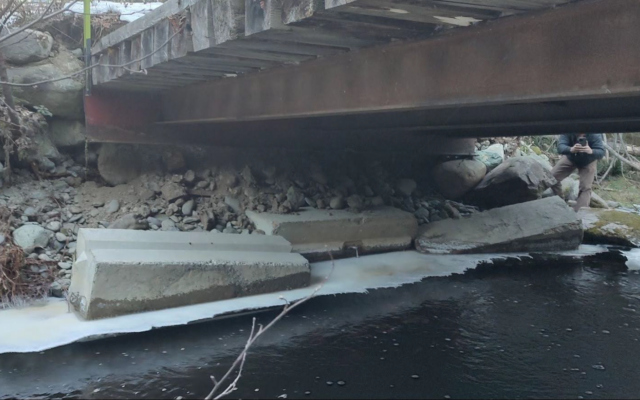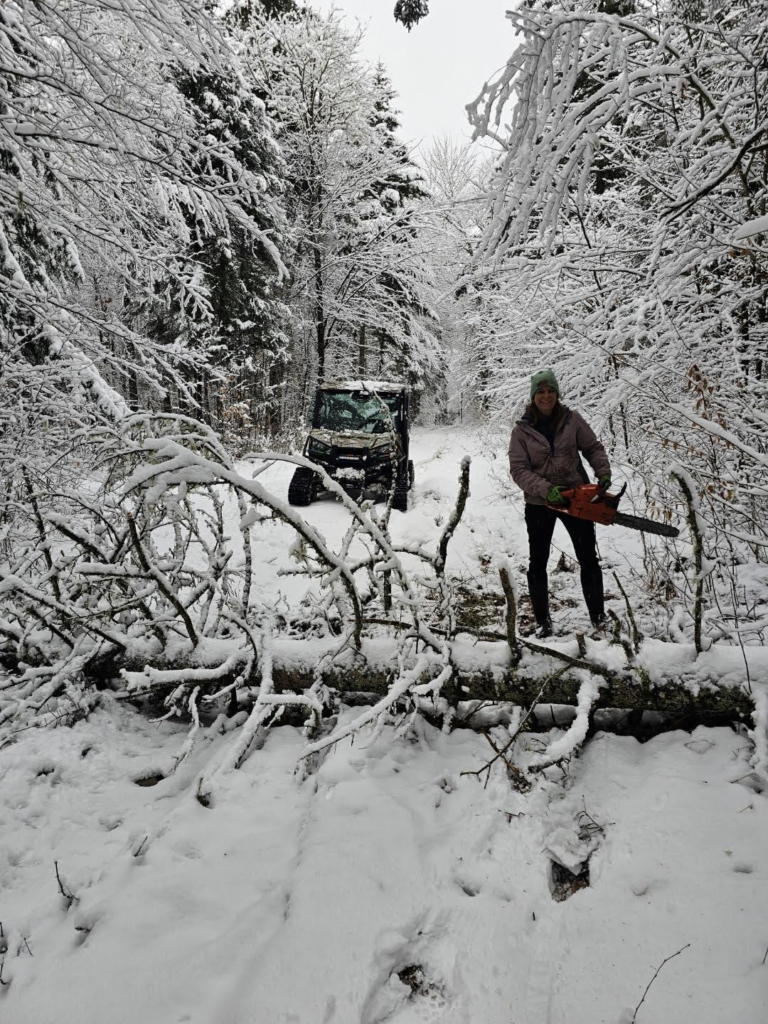
Devastated trails threaten Maine’s snowmobile season
By Julie Harris, Bangor Daily News Staff
With not enough volunteers and very little money, Maine snowmobile clubs are scrambling to reopen or reroute sections of the International Trail System damaged by the fierce wind and rain storm on Dec. 18.
Snowmobilers contribute more than $600 million to the state’s economy, including direct spending and jobs that serve snowmobilers, according to a University of Maine study released in 2020. The lack of snow thus far in the season and the extensive damage wreaked by the pre-Christmas storm could put that revenue at risk.
It is the fourth major storm in less than a year that has left snowmobile trails with what likely is millions of dollars in damage. Some clubs had just finished repairing trails battered by the heavy rains in June and July, and others were still trying to fix them before the first major snow, according to Joe Higgins of the Maine Snowmobile Association.

LOSS OF SUPPORT — This side of the ITS 66 bridge in Rockwood lost all of its supports on one side and the material behind the supports was pushed into the river. This bridge needs to be picked up, the material needs to be pushed back and then the supports need to be reset and secured.
The other two storms were on Dec. 23, 2022, and May 1, 2023.
“We have had four 100-year storms in one year,” Higgins said.
Bridges across streams were moved or destroyed by flood waters, culverts were washed out, large gullies were etched in trails and thousands of trees were felled in the Dec. 18 storm. Even while they waited for power to be restored at their own houses, dozens of volunteers feverishly began to clear the trails before Maine got substantial snow.
Most of the trail damage is in central and western Maine. Aroostook County trails had some flooding and blown down trees, but not the utter destruction more central and western areas of the state saw.
Ashland Sno-mobile Club reported light gravel wash, flooded sections that were freezing over and trees across the trails, but was quickly cleaning things up.
Clubs like Piscataquis Valley, Blue Ridge Riders in Rockwood, Moosehead Riders, Jo Mary Riders, Forks Area Trails Club, Eastern Maine Snowmobilers and Ebeemee reported displaced or destroyed bridges, washed out culverts and deep washouts on trails, in addition to thousands of toppled trees blocking the trails.
The Maine Snowmobile Association has appealed to the state, including the governor’s office, for money and help to repair the trails. It also is looking into other potential funding sources.

VOLUNTEER WORK — Blue Ridge Riders Snowmobile Club in Rockwood had a great group of volunteers help clear ITS 66. This is Sarah Wheelock getting ready to cut up a tree blocking the trail.
The association’s nearly 300 clubs were encouraged to assess and document damage and estimates to fix it, which could be used to seek funding, Higgins said. Damage reports and estimates are still pouring in.
And it’s not just the need for funding, Higgins said. Maine’s clubs maintain approximately 14,000 miles of trails, 95 percent of which are on privately owned land. The trail system, which is the largest in New England, was built and is maintained by volunteers who work with landowners whenever changes need to be made.
With the damage from these storms, some landowners have helped clubs right some of the trails by physically working on them or providing equipment, or at the very least, granting permission to make changes, but many more volunteers are needed, he said.
The task of repairing this much damage is staggering. Piscataquis Valley Snowmobile Club saw about a dozen members put in more than 100 hours of work combined to primarily clear fallen trees off the trails, said Brian Rhodes, club trail master.
The club fixed a railbed trail and opened ITS 85 and 82 in its section. There are a couple of washouts that will have to wait because it’s still too muddy to get equipment to them, he said.
He has more than 100 landowners he works with for the club’s 45 miles of trails.
“We lucked out. It could have been worse,” he said. “Other clubs got hit with big damage.”
One of those is Eastern Maine Snowmobilers, which maintains 80 miles of trails in Penobscot and Hancock counties. About 20 miles belong to ITS Connector 107 from Bucksport toward Milford, where there are so many trees down, the club’s core of about a half dozen workers has put in 57 hours to be only a third done clearing them out.
The club had replaced two bridges damaged by one of the prior storms and secured one of them with a 100-foot cable, said Larry Lafland, trail master. The bridge held for the December storm.
But a section of rail trail from Brewer to Holden is closed because there are several washouts, including one where the railroad ties were washed out from a prior storm and there is no money, equipment or labor to fix it right now, he said.
Part of the problem is a severe lack of volunteers, which seems to be a theme statewide.
“It’s going to be a tough year for the whole state,” said Lafland, who has been maintaining trails since 1989. “The governor is looking to get FEMA money, but we need people and man hours. It’s more important than money.”
Blue Ridge Riders in Rockwood had one bridge out and dozens of downed trees that needed to be cleared off ITS 66, club member Kate Tiffany said. There was a huge 8-10-foot washout down the middle of ITS 66 that Joel Willard of The Birches Resort helped the club fix.
The Birches maintains the ITS 88 connector from Rockwood to Jackman, but there is a 10-foot-wide, 140-foot bridge washed out that likely will not be replaced this winter because it’s too wet to get equipment where it’s needed, she said.
Six major bridges throughout the ITS have been replaced since the storm, and 10-12 smaller bridges and trails were repaired just in the last week, Higgins said.
The storm wiped out five years worth of work for The Forks Area Trails Club, which maintains 60-70 miles of trails, mostly in the ITS, trail master Benjamen Towle said.
McNaughton Brothers construction company volunteered their equipment to fix a bridge, otherwise there would have been no connection between The Forks and Bingham this year, Towle said.
Landowner Weyerhaeuser also cooperated, and the Maine Department of Environmental Protection issued a permit to allow the bridge to be put back where it was, he said.
It would be helpful in the future if there were less red tape to make such major repairs, Towle said.
Towle, whose town has 39 residents, said the club will have to do another $100,000 in earthwork on the trails in the spring. He has no idea where the club will find the money.
The Forks is also looking at closing 35 miles of the International Trail System that goes to Bingham because of a washed out bridge. It will reroute the connection through club trails.
He suggested that tax incentives for landowners, contractors that specialize in trail building and repairs and cooperation between snowmobile and all-terrain vehicle clubs would all help ensure these activities remain available.
“People will look at booking elsewhere if there are no trails. Something has to change. It’s too big a sport now,” he said.
No one expected this kind of damage, Higgins said. There are still projects from the May 1 storm, but the ground is too saturated with water to get equipment out to some parts of the trails.
The Maine Snowmobile Association has encouraged clubs to focus on the main arteries that make up the International Trail System that bring tourism to the state. Landowners have been phenomenal, allowing clubs to reroute trails and to use logging roads as connectors, Higgins said.
Even some owners of seasonal camps and residences came to Maine last week to help with some of the trails, he said.
“We will have snowmobile trails this winter. There will be reroutes, so riders should plan ahead by checking with clubs for changes. And if you really want to help, join a club and think about volunteering,” Higgins said.